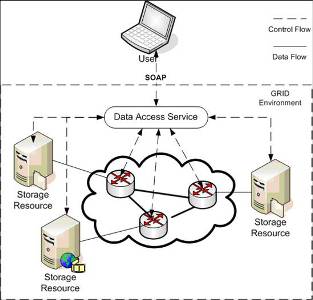| |
Institute on Grid Systems, Tools and Environments
Institute leader: Vladimir Getov (V.S.Getov westminster.ac.uk), University of Westminster westminster.ac.uk), University of Westminster
|  |
The research activities of this Institute are focused around the design of novel software environments and tools for GRID systems. The main objective is to develop the design methodology for generic component GRID systems that integrate application components, tools/system components, problem solving environments (PSE)/portal components, and infrastructure components. Our approach encompasses both the adoption of the component model, and its integration into a tools framework, which consists of an integrated components GRID platform, a component support toolkit, and a generic problem-solving toolkit. The design of such a platform will advance significantly the state-of-the-art. It will enable the specification of a core (generic) component-based platform for both applications and tools/systems/PSEs to have a single, seamless “invisible” GRID software infrastructure. The results from this research are expected to be equally valid for both the client/server and the peer-to-peer paradigms. Roadmap version 3 on Grid Systems, Tools and Environments
Publications related to the Institute on Grids Systems, Tools and Environments
|
|
Research Group
|
Leader
|
Participants
|
Design Methodology for a Generic Component Grid Platform
|
UoW
|
UoW, IC, CYFRONET, IPP-BAS, UPC, INRIA
|
Security in Grid Platforms
|
IPP-BAS
|
IPP-BAS, CYFRONET, UoW, ICS-FORTH, VUA
|
Integration of Information Sources into an Application-Level Information Cache Mediator Component
|
VUA
|
VUA, SZTAKI, UNILE, CYFRONET
|
Application Deployment Component
|
INRIA
|
INRIA, UWC, UoW, UPC, IC, HLRS, UNIPI
|
| Integrated Programming and Runtime Environments |
UPC
|
UPC, USTUTT, SZTAKI, VUA, CYFRONET, UWC, INRIA, UNILE, UNIPI |
| Efficient Component Composition |
IC
|
IC, UoW, UPC, INRIA
|
| Legacy Code Wrapping and Deployment Methodologies |
UoW
|
UoW, UWC, CYFRONET, SZTAKI, ICS-FORTH |
| Grid Portals |
SZTAKI
|
SZTAKI, UWC, UoW, UNILE |
|
|
|
|
Latest Research Highlights |
A data sharing protocol for Desktop Grid projects CoreGRID Technical Report TR-0165 [pdf]:
Service grids and desktop grids are great solutions for solving the available compute power problem and helping to balance loads across network systems. However, with the objective to support new scientific communities that need extremely large numbers of resources, the solution could be to interconnect these two kinds of Grid systems into an integrated Service GridDesktop Grid (SG-DG) infrastructure. In this paper, we describe an architecture that exploits technological bridges to facilitate service and desktop grid interoperability, define the adopted data sharing protocol and present a performance evalution.
| 
| Globally Optimal Bulk Data Transfers in Overlay Routing Networks CoreGRID Technical Report TR-0157 [pdf]: This report describes the results of a six-week research visit by the first author to the INRIA RESO research group at ENS Lyon. We address the problem of scheduling bulk data transfers in routing overlays running over public networks, in a globally optimal manner. One challenge encountered in this endeavor is to jointly address the global optimization of routes taken by transfers in the routing overlay, one one hand, and the transfer schedules in the time domain, on the other, such that a single global objective is optimized (we currently choose minimizing global network congestion as our objective). In this direction, we explore two alternative approaches, one based on a linear programming optimization, and another on oblivious routing strategies. A second challenge in scheduling deadline-constrained transfers in a public network setting is dealing with uncertainties in future resource availability (e.g. available bandwidths) given by the presence of cross-traffic. For this, we propose using distributions rather than fixed values for describing network links and further deriving probabilistic guarantees for deadlines to be met based on the distributions of transfer paths chosen by our algorithm. Our system is currently still in a development and testing phase. We plan evaluations based on trace-driven simulations, using traces collected on PlanetLab by us and traces we downloaded from the S3 measurement project. We will use S3 traces we have been collecting for about two months. Depending on the outcome of the simulation approach and on other practical factors, we might also evaluate the system by running a full-fledged implementation over PlanetLab. Applications of our approach include p2p networks used for data transfers, QoS-enhancing routing overlays such as [5] [19] [12], SETI@home-like p2p computing, with deadline constraints, over large scale data (e.g. astronomic streams), as well as any scenario in which a distributed organization needs to transfer and process large amounts of data over public networks with deadline constraints. | 
| Autonomic Behavior of Grid Applications using Component Platforms CoreGRID Technical Report TR-0156 [pdf]:
In this report, we present the results of a two-week research visit by the first author to the University of Pisa. We argue that problems like load-balancing or fault-tolerance can be addressed by integrating autonomic behavior in existing Grid applications. This can be achieved either by investigating novel approaches, such as multi-objective strategies, or by enhancing existing, specific solutions like cluster-aware random stealing [11] or empirically determined threshold of compute nodes [15]. We investigate both the JavaGAT [12] and Satin [14] systems to be augmented by autonomic behavior, based on autonomic managers from Muskel [7]. The main outcome of this report are items of future research work.
| 
|
|
|
| |
|
|
 Institutes
Institutes  Institute on STE
Institute on STE